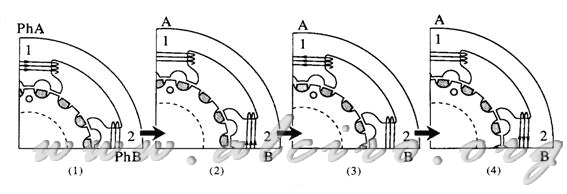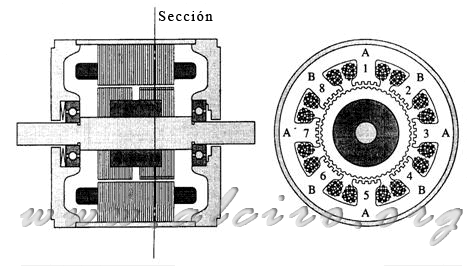1.3.1. Hybrids of two and four phases

Figure 2.15. Section of a hybrid stepper motor has two phases.
The use of two-phase hybrid engines is highly extended, thanks to its simplicity and control over other models with more stages. The structure of this model can be seen in Figure 2.15. This has four poles in the stator. Pole winding 1 is connected in series with the winding forming pole 3-phase which is excited. The windings in series of poles 2 and 4 are the phase B.
When the rotor is in a position of equilibrium with one phase excited, polo teeth of a stator phase match the teeth of the permanent magnet's north pole, and the other pole to south pole.
The operation for an active phase sequence shown in Figure 2.16. In state 1 the poles of phase A is excited, and the teeth of pole 1 attract the rotor teeth of the north pole while the pole 3 equally attracted to the teeth of the south pole of the rotor. When the current (i) is switched to phase B (state 2), the rotor moves a quarter of a tooth space, leaving the north pole aligned with the rotor 2 stator pole and south pole of the rotor with 4 of the stator pole. Again, the current (-i) is changed to phase A (state 3) produced a further shift of the fourth rotor tooth space, being aligned in opposite directions (with south pole pole 1 and pole 3 with North Pole) . Another current switching (-i) in phase B (state 4) produce a new re-alignment movement and reverse the poles of this phase with the rotor. Returning to state 1 (i), the rotor has 4 steps of a quarter of the space of a tooth. From this we deduce that the angle of the step is:
}=\frac{Espacio\ diente}{4}=\frac{\frac{360}{n_{ dientes}}}{4}=\frac{\frac{360}{50}}{4}=1.8\ Grados) (2.3)
(2.3)

Figure 2.16. Operation of an active phase of a hybrid of two phases.
The structure of two-phase motor shown in Figure 2.15 is little used and that the force generated is not symmetrical about the axis. An engine model used, 200 steps per revolution, and eight poles in the stator shown in Figure 2.17. The increase to four poles for each of the phases, distributed around the stator in this structure produces the torque generated is symmetrical across the surface of the rotor. A section of this engine can be seen in Figure 2.18.
A four-phase motor can be built following the model of the structure shown in Figure 2.17, bringing together opposites in one stage. This type of engine it is rare to find because the control circuit increases with the number of phases

Figure 2.17. Motor hybrid of eight poles.







